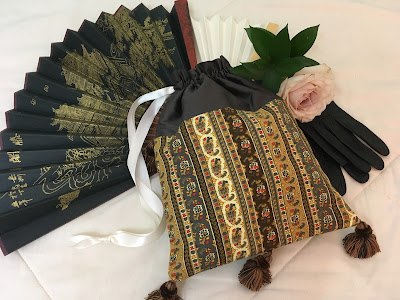How about a sewing round-up to kick off this month's blogging? Today's post is all about the accessories, those finishing touches that pull the outfit together!
As introduced in the article, "The Soldier’s Hussif," which presents an illustrated history of the military sewing kit from the American Civil War to the 1990s:
2 Regency Reticules



Way back in December, I put together three, little satisfying projects that hopefully will get lots of use in the coming months:
1 Hussif or Housewife
Hussif | noun |
1. A little case or bag for materials used in sewing,
and for other articles of female work.
2. Origin - From Middle English huswif, equivalent to house + wife
"The term 'housewife' refers to a sewing kit but housewife was not the only term used. They were also known as huswife, hussive, or, most commonly, hussif, which appears to be the contraction of the word 'housewife'. By the beginning of the Regency, hussif was the term most often used to refer to these small pocket sewing kits by nearly everyone, though pronunciation of the word would vary from region to region across Britain." - Nicola, author and designer at Hands Across the Sea Samplers
My hussif or housewife is completely hand stitched from a variety of reproduction cottons, heavy weight linen for the interior lining, and wool scraps for the needle pages:
What I like best is that each of the fabrics used, minus the orange which was a gift from my partner in crime, Judy, came from previous projects. Dresses, a short gown, petticoat, a tiny sacque coat for C - small accessories are a perfect way to put those fabric scraps to use!
 |
| Rolled up and ready for action! |
2 Regency Reticules
Reticule | noun | \ˈre-ti-ˌkyül\
1. A woman's small handbag, originally netted and typically having a drawstring
and decorated with embroidery or beading.
2. Origin - Early 18th century: French réticule, from Latin reticulum
A while ago, The Dreamstress published a fascinating article on the use of reticules and the ridicule they inspired at first in "Terminology: What is a reticule or indispensable?" It's a very interesting read, if you haven't already through the original Historical Sew Fortnightly. On the reticule's rise to fashion, she writes:
"At the end of the 18th century, as fashions changed from full skirted dresses that could easily conceal pockets, to slim garments of light fabrics that would show unsightly bulges over pockets, that reticules came into their own. Easily made, easily carried, they were the indispensable accessory of the last decade of the 18th century and the first three decades of the 19th. They were, in fact, so very indispensable that they were also known as indispensables." - The Dreamstress, Leimomi Oakes
Intended for an upcoming Jane Austen Festival, I set out to make two, new indispensables of my own. Eventually, the should have coordinating outfits too haha!
The first was inspired by this extant in a private collection - unfortunately, I cannot locate the source, and would love to recover it to give credit:

Mine is constructed from a beautiful wool challis, dark grey/black silk taffeta and white twill for the lining. The tassels were a compromise, cut from home decor trim:


Intended for day use, it's a pretty good size at about 11" top to bottom and just under 9" at the sides. It's my favorite of the projects shared in this post, and I'm so looking forward to using it at an event!
The second, triangular reticule came from the American Girl's Book by Miss Eliza Leslie, first published in 1831:
 |
"Cut your silk into three pieces of equal size. Each must be about a quarter of a yard in depth, and half a quarter wide. The sided of each must be straight till within a finger’s length of the bottom; they must then be sloped off to a point. Sew those three pieces of silk together, (inserting a covered cord between the seams,) and make them all meet in a point at the bottom. Put a tassel or bow at each corner, and one at the bottom. Hem down the top, and run a ribbon into it." - American Girl’s Book (1831) by Miss Eliza Leslie
 |
| A Three Sided Reticule. (Source: World Turn'd Upside Down) |
My version was constructed from a vibrant, striped silk taffeta and lined in polished cotton. It is just under 10" from top to bottom.
Best of all, it feature the same tassels as the first; and, despite how neat it looks, I never want to have to deal with three tassels at a point again!
Have you reproduced a Regency reticule recently? Thanks for reading!















Oooh, the triangle reticule is so fun! How great to find period instructions, too.
ReplyDeleteIf you get the chance, the American Girl’s Book (1831) has all sorts of fun sewing projects! :)
Delete